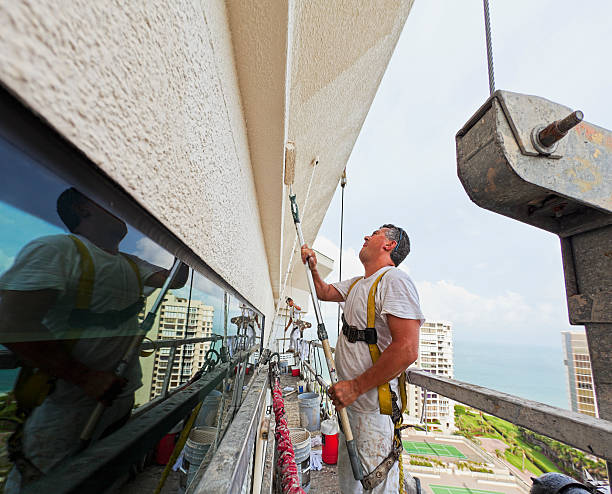Maintaining a commercial building is crucial for ensuring the safety, comfort, and functionality of the space, as well as protecting the investment of property owners and tenants. Effective building maintenance involves proactive planning, regular inspections, and timely repairs to address issues before they escalate into costly problems. In this article, we’ll explore key strategies for commercial building maintenance to help property owners and managers keep their buildings in top condition.
1. Develop a Comprehensive Maintenance Plan
A well-defined maintenance plan serves as a roadmap for keeping a commercial building in optimal condition. Start by conducting a thorough assessment of the building’s systems, including HVAC, plumbing, electrical, and structural components. Identify potential maintenance tasks, prioritize them based on urgency and importance, and schedule regular inspections and preventive maintenance activities. A comprehensive maintenance plan should also include provisions for emergency repairs and contingency measures.
2. Regular Inspections and Maintenance Checks
Regular inspections are essential for identifying potential issues and addressing them before they escalate into major problems. Schedule routine inspections of the building’s interior and exterior, including HVAC systems, plumbing fixtures, electrical components, roofing, and structural elements. Look for signs of wear and tear, water damage, leaks, cracks, and other signs of deterioration. Address any issues promptly to prevent further damage and ensure the safety and comfort of occupants.
3. Prioritize Safety and Compliance
Safety should be a top priority in commercial building maintenance. Ensure that the building complies with all relevant safety codes and regulations, including fire safety, ADA accessibility, and building occupancy limits. Regularly inspect fire suppression systems, emergency exits, stairwells, and other safety features to ensure they are in working order. Health and safety training is crucial for maintenance staff to identify and address any safety hazards or violations promptly to mitigate risks and protect occupants and visitors.
4. Implement Preventive Maintenance Programs
Preventive maintenance programs are designed to identify and address potential issues before they result in costly repairs or downtime. Implement preventive maintenance schedules for critical building systems and equipment, such as HVAC units, boilers, elevators, and electrical panels. Regularly clean, lubricate, and inspect equipment to ensure optimal performance and extend its lifespan. Investing in preventive maintenance can help avoid unexpected breakdowns and costly repairs, saving time and money in the long run.
5. Invest in Energy Efficiency
Energy efficiency is not only good for the environment but also for the bottom line. Implement energy-saving measures such as LED lighting upgrades, programmable thermostats, and energy-efficient appliances to reduce utility costs and minimize environmental impact. Conduct energy audits to identify opportunities for improvement and prioritize upgrades based on potential cost savings and return on investment. Investing in energy efficiency can lead to significant long-term savings and enhance the value of the building.
6. Address Maintenance Requests Promptly
Effective communication between property managers, tenants, and maintenance staff is essential for addressing maintenance issues promptly. Implement a system for reporting and tracking maintenance requests, whether through an online portal, email, or phone hotline. Respond to maintenance requests in a timely manner and prioritize them based on urgency and severity. Keep tenants informed of maintenance schedules and updates to ensure transparency and minimize disruptions to their operations.
7. Partner with Qualified Contractors and Service Providers
Building maintenance often requires specialized skills and expertise, particularly for complex systems and equipment. Partner with qualified contractors and service providers who have experience working with commercial buildings and can provide reliable, high-quality services. Vet potential contractors carefully, check references, and ensure they are properly licensed, bonded, and insured. Establish clear expectations and communication channels to ensure smooth coordination and collaboration between all parties involved.
8. Plan for Long-Term Maintenance and Upgrades
Effective building maintenance requires a long-term perspective and strategic planning. Develop a capital improvement plan to address deferred maintenance, prioritize upgrades, and plan for future renovations or expansions. Allocate budgetary resources for major maintenance projects and upgrades, and regularly review and adjust the plan as needed based on changing priorities and conditions. Planning for long-term maintenance and upgrades can help preserve the value and longevity of the building while ensuring its continued functionality and relevance.
Conclusion
Effective commercial building maintenance requires proactive planning, regular inspections, and timely repairs to ensure the safety, comfort, and functionality of the space. By developing a comprehensive maintenance plan, prioritizing safety and compliance, implementing preventive maintenance programs, investing in energy efficiency, addressing maintenance requests promptly, partnering with qualified contractors, and planning for long-term maintenance and upgrades, property owners and managers can keep their buildings in top condition and protect their investment for years to come. With careful planning and attention to detail, commercial building maintenance can enhance the value and performance of the property while providing a safe and welcoming environment for occupants and visitors.
